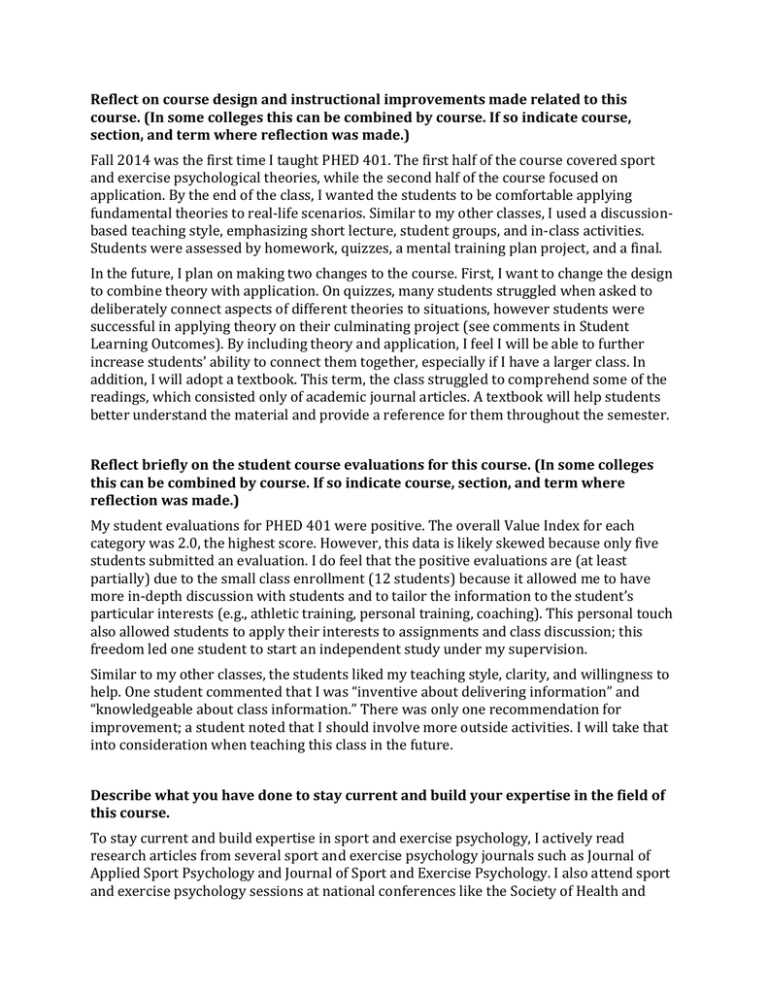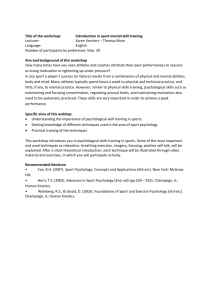Reflect on course design and instructional improvements made
advertisement

Reflect on course design and instructional improvements made related to this course. (In some colleges this can be combined by course. If so indicate course, section, and term where reflection was made.) Fall 2014 was the first time I taught PHED 401. The first half of the course covered sport and exercise psychological theories, while the second half of the course focused on application. By the end of the class, I wanted the students to be comfortable applying fundamental theories to real-life scenarios. Similar to my other classes, I used a discussionbased teaching style, emphasizing short lecture, student groups, and in-class activities. Students were assessed by homework, quizzes, a mental training plan project, and a final. In the future, I plan on making two changes to the course. First, I want to change the design to combine theory with application. On quizzes, many students struggled when asked to deliberately connect aspects of different theories to situations, however students were successful in applying theory on their culminating project (see comments in Student Learning Outcomes). By including theory and application, I feel I will be able to further increase students’ ability to connect them together, especially if I have a larger class. In addition, I will adopt a textbook. This term, the class struggled to comprehend some of the readings, which consisted only of academic journal articles. A textbook will help students better understand the material and provide a reference for them throughout the semester. Reflect briefly on the student course evaluations for this course. (In some colleges this can be combined by course. If so indicate course, section, and term where reflection was made.) My student evaluations for PHED 401 were positive. The overall Value Index for each category was 2.0, the highest score. However, this data is likely skewed because only five students submitted an evaluation. I do feel that the positive evaluations are (at least partially) due to the small class enrollment (12 students) because it allowed me to have more in-depth discussion with students and to tailor the information to the student’s particular interests (e.g., athletic training, personal training, coaching). This personal touch also allowed students to apply their interests to assignments and class discussion; this freedom led one student to start an independent study under my supervision. Similar to my other classes, the students liked my teaching style, clarity, and willingness to help. One student commented that I was “inventive about delivering information” and “knowledgeable about class information.” There was only one recommendation for improvement; a student noted that I should involve more outside activities. I will take that into consideration when teaching this class in the future. Describe what you have done to stay current and build your expertise in the field of this course. To stay current and build expertise in sport and exercise psychology, I actively read research articles from several sport and exercise psychology journals such as Journal of Applied Sport Psychology and Journal of Sport and Exercise Psychology. I also attend sport and exercise psychology sessions at national conferences like the Society of Health and Physical Educators of America. Finally, I actively search popular media for critical issues and current events. Identify 1 to 3 student learning outcomes that you focused on this semester. Briefly describe the assessment methods and instruments used to measure the outcomes. Then discuss assessment results in a manner that illustrates what you have learned, what the students learned, and how you will use this in future courses. Course Level (required) Student Learning Outcome 3: Demonstrate the ability to apply the knowledge gained in the area of sport and exercise psychology to practical situations To assess this outcome, I used the Mental Training Plan (MTP), the culminating project requiring each student to design a three-month, personalized mental training by applying three theories and/or models discussed in class. The project required the students’ interview the person, write the MTP, and give a brief class presentation. The presentation was worth 100 points. A rubric was used for grading; students were given up to 50 points for the written plan and up to 50 points for the presentation. I feel this outcome was met. The average grade was 92 points, with a median grade of 94 points. This small class had some exceptional students, as the lowest grade was only 80 points. I was impressed by the detail and integration each student used in both graded portions of the MTP, especially when some of the students struggled with applying theory to situations on the quizzes (see comment in Course Design and Improvement). I learned that students enjoy learning how to apply the material outside of the classroom. In addition, I learned that part of the success of this learning outcome was due to the small class size, which allowed me to give multiple examples throughout the semester, especially towards the end. Larger class sizes, while not a problem, may require me to change my approach to this learning outcome. In the future, I will continue to have my students apply theory to real-world application, but depending on the class size, I may change the nature of the assessment.


